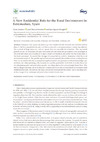Identificador persistente para citar o vincular este elemento:
https://accedacris.ulpgc.es/jspui/handle/10553/114462
| Campo DC | Valor | idioma |
|---|---|---|
| dc.contributor.author | Jiménez Barrado, Victor | en_US |
| dc.contributor.author | Sánchez, José-Manuel | en_US |
| dc.contributor.author | Rengifo, Juan-Ignacio | en_US |
| dc.date.accessioned | 2022-04-27T17:27:20Z | - |
| dc.date.available | 2022-04-27T17:27:20Z | - |
| dc.date.issued | 2019 | en_US |
| dc.identifier.issn | 2071-1050 | en_US |
| dc.identifier.uri | https://accedacris.ulpgc.es/handle/10553/114462 | - |
| dc.description.abstract | European rural spaces are assuming a new residential role. In some such as Extremadura (Spain), the low population density and the practice of an extensive primary sector has allowed the survival of large areas and natural spaces that are desirable for urbanites. The residential growth caused by economic changes and tourist attractiveness has generated a new paradigm in which recreational use competes with agricultural and livestock use (until now the sustenance of the local economy). To record this change, it is essential to spatially determine what the rural environment means in this specific regional context and quantify the number of new existing homes. First, we resorted to the future competent legislation (born of experience and local knowledge) and territorial and urban planning, while second, we used the potentiality of all of the available free series of orthophotography and aerial photography including other tools such as Google Street View. This methodological process led us to discover a recent and important advancement of the recreational residential function. On balance, the data showed that recreational residential use is a leading actor in the change of the landscape and productive model of rural areas. | en_US |
| dc.language | eng | en_US |
| dc.relation.ispartof | Sustainability (Switzerland) | en_US |
| dc.source | Sustainability [2071-1050], 2019, 11(2), 435 | en_US |
| dc.subject | 540402 Geografía rural | en_US |
| dc.subject | 332904 Uso del suelo | en_US |
| dc.subject.other | Second homes | en_US |
| dc.subject.other | Rurbanization | en_US |
| dc.subject.other | Rural tourism | en_US |
| dc.subject.other | Rural development | en_US |
| dc.subject.other | Extremadura | en_US |
| dc.title | A New Residential Role for the Rural Environment in Extremadura, Spain | en_US |
| dc.type | info:eu-repo/semantics/article | en_US |
| dc.type | Article | en_US |
| dc.identifier.doi | 10.3390/su11020435 | en_US |
| dc.investigacion | Artes y Humanidades | en_US |
| dc.type2 | Artículo | en_US |
| dc.description.numberofpages | 14 | en_US |
| dc.utils.revision | Sí | en_US |
| dc.identifier.ulpgc | No | en_US |
| dc.contributor.buulpgc | BU-HUM | en_US |
| dc.description.sjr | 0,581 | |
| dc.description.jcr | 2,576 | |
| dc.description.sjrq | Q2 | |
| dc.description.jcrq | Q2 | |
| dc.description.scie | SCIE | |
| dc.description.ssci | SSCI | |
| dc.description.erihplus | ERIH PLUS | |
| item.grantfulltext | open | - |
| item.fulltext | Con texto completo | - |
| crisitem.author.dept | GIR IATEXT: Sociedades y Espacios Atlánticos | - |
| crisitem.author.dept | IU de Análisis y Aplicaciones Textuales | - |
| crisitem.author.dept | Departamento de Geografía | - |
| crisitem.author.orcid | 0000-0001-7064-7465 | - |
| crisitem.author.parentorg | IU de Análisis y Aplicaciones Textuales | - |
| crisitem.author.fullName | Jiménez Barrado, Victor | - |
| Colección: | Artículos | |
Citas de WEB OF SCIENCETM
Citations
7
actualizado el 08-jun-2025
Visitas
97
actualizado el 21-dic-2024
Descargas
27
actualizado el 21-dic-2024
Google ScholarTM
Verifica
Altmetric
Comparte
Exporta metadatos
Los elementos en ULPGC accedaCRIS están protegidos por derechos de autor con todos los derechos reservados, a menos que se indique lo contrario.
